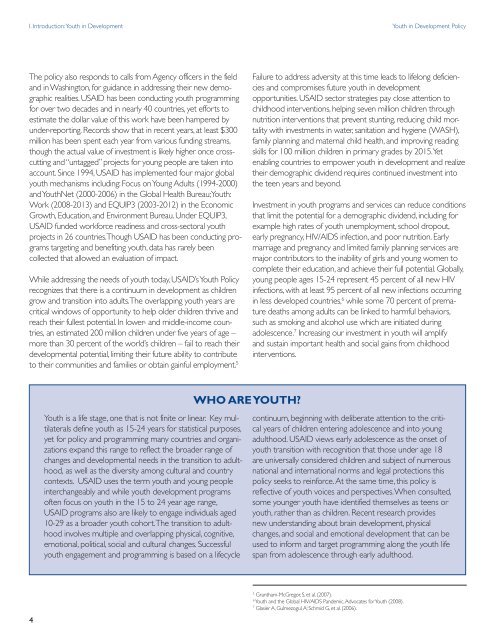YOUTH IN DEVELOPMENT Realizing the Demographic Opportunity USAID POLICY YOUTH
YOUTH IN DEVELOPMENT Realizing the Demographic Opportunity USAID POLICY YOUTH
YOUTH IN DEVELOPMENT Realizing the Demographic Opportunity USAID POLICY YOUTH
Create successful ePaper yourself
Turn your PDF publications into a flip-book with our unique Google optimized e-Paper software.
I. Introduction:Youth in Development Youth in Development Policy<br />
The policy also responds to calls from Agency officers in <strong>the</strong> field<br />
and inWashington, for guidance in addressing <strong>the</strong>ir new demographic<br />
realities. <strong>USAID</strong> has been conducting youth programming<br />
for over two decades and in nearly 40 countries, yet efforts to<br />
estimate <strong>the</strong> dollar value of this work have been hampered by<br />
underreporting. Records show that in recent years, at least $300<br />
million has been spent each year from various funding streams,<br />
though <strong>the</strong> actual value of investment is likely higher once crosscutting<br />
and “untagged” projects for young people are taken into<br />
account. Since 1994, <strong>USAID</strong> has implemented four major global<br />
youth mechanisms including: Focus onYoung Adults (19942000)<br />
andYouthNet (20002006) in <strong>the</strong> Global Health Bureau;Youth:<br />
Work (20082013) and EQUIP3 (20032012) in <strong>the</strong> Economic<br />
Growth, Education, and Environment Bureau. Under EQUIP3,<br />
<strong>USAID</strong> funded workforce readiness and crosssectoral youth<br />
projects in 26 countries.Though <strong>USAID</strong> has been conducting programs<br />
targeting and benefiting youth, data has rarely been<br />
collected that allowed an evaluation of impact.<br />
While addressing <strong>the</strong> needs of youth today, <strong>USAID</strong>’sYouth Policy<br />
recognizes that <strong>the</strong>re is a continuum in development as children<br />
grow and transition into adults.The overlapping youth years are<br />
critical windows of opportunity to help older children thrive and<br />
reach <strong>the</strong>ir fullest potential. In lower and middleincome countries,<br />
an estimated 200 million children under five years of age –<br />
more than 30 percent of <strong>the</strong> world’s children – fail to reach <strong>the</strong>ir<br />
developmental potential, limiting <strong>the</strong>ir future ability to contribute<br />
to <strong>the</strong>ir communities and families or obtain gainful employment. 5<br />
4<br />
WHO ARE<strong>YOUTH</strong>?<br />
Failure to address adversity at this time leads to lifelong deficiencies<br />
and compromises future youth in development<br />
opportunities. <strong>USAID</strong> sector strategies pay close attention to<br />
childhood interventions, helping seven million children through<br />
nutrition interventions that prevent stunting, reducing child mortality<br />
with investments in water, sanitation and hygiene (WASH),<br />
family planning and maternal child health, and improving reading<br />
skills for 100 million children in primary grades by 2015.Yet<br />
enabling countries to empower youth in development and realize<br />
<strong>the</strong>ir demographic dividend requires continued investment into<br />
<strong>the</strong> teen years and beyond.<br />
Investment in youth programs and services can reduce conditions<br />
that limit <strong>the</strong> potential for a demographic dividend, including for<br />
example high rates of youth unemployment, school dropout,<br />
early pregnancy, HIV/AIDS infection, and poor nutrition. Early<br />
marriage and pregnancy and limited family planning services are<br />
major contributors to <strong>the</strong> inability of girls and young women to<br />
complete <strong>the</strong>ir education, and achieve <strong>the</strong>ir full potential. Globally,<br />
young people ages 1524 represent 45 percent of all new HIV<br />
infections, with at least 95 percent of all new infections occurring<br />
in less developed countries, 6 while some 70 percent of premature<br />
deaths among adults can be linked to harmful behaviors,<br />
such as smoking and alcohol use which are initiated during<br />
adolescence. 7 Increasing our investment in youth will amplify<br />
and sustain important health and social gains from childhood<br />
interventions.<br />
Youth is a life stage, one that is not finite or linear. Key mul continuum, beginning with deliberate attention to <strong>the</strong> crititilaterals<br />
define youth as 1524 years for statistical purposes, cal years of children entering adolescence and into young<br />
yet for policy and programming many countries and organi adulthood. <strong>USAID</strong> views early adolescence as <strong>the</strong> onset of<br />
zations expand this range to reflect <strong>the</strong> broader range of youth transition with recognition that those under age 18<br />
changes and developmental needs in <strong>the</strong> transition to adult are universally considered children and subject of numerous<br />
hood, as well as <strong>the</strong> diversity among cultural and country national and international norms and legal protections this<br />
contexts. <strong>USAID</strong> uses <strong>the</strong> term youth and young people policy seeks to reinforce.At <strong>the</strong> same time, this policy is<br />
interchangeably and while youth development programs reflective of youth voices and perspectives.When consulted,<br />
often focus on youth in <strong>the</strong> 15 to 24 year age range, some younger youth have identified <strong>the</strong>mselves as teens or<br />
<strong>USAID</strong> programs also are likely to engage individuals aged youth, ra<strong>the</strong>r than as children. Recent research provides<br />
1029 as a broader youth cohort.The transition to adult new understanding about brain development, physical<br />
hood involves multiple and overlapping physical, cognitive, changes, and social and emotional development that can be<br />
emotional, political, social and cultural changes. Successful used to inform and target programming along <strong>the</strong> youth life<br />
youth engagement and programming is based on a lifecycle span from adolescence through early adulthood.<br />
5 GranthamMcGregor, S, et al. (2007).<br />
6 Youth and <strong>the</strong> Global HIV/AIDS Pandemic,Advocates forYouth (2008).<br />
7 Glasier A, Gulmezogul,A; Schmid G, et al. (2006).


